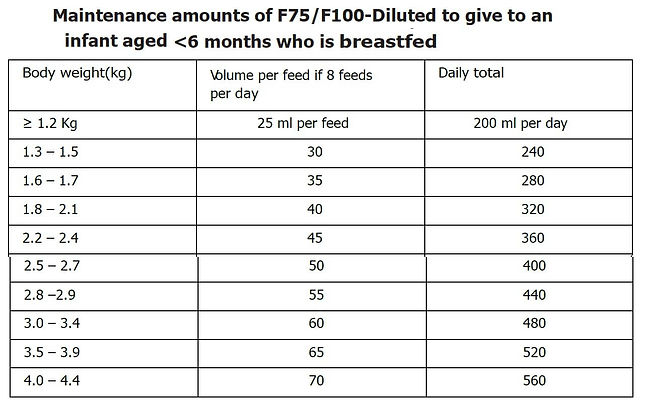By ULY CLINIC Staff,
Acute Malnutrition
Acute Malnutrition (wasting) is a rapid decline of weight while height remains unchanged. It is a reflection of inadequate dietary intake or acute infection.
It is classified into severe acute malnutrition (SAM) and moderate acute malnutrition (MAM) according to the degree of wasting and the presence or absence of oedema.
Severe Acute Malnutrition
It is defined as oedema of both feet and visible severe wasting.
Diagnostic Criteria
-
Visible severe wasting
-
Oedema of both feet
-
Weight for length/height <-3SD
-
MUAC < 11.5 cm
Investigations:
-
RBG
-
BS for MPS
-
Septic screening; Urine culture, Blood culture, Swab cultures
-
FBP
-
HIV screening
-
Chest X ray
Treatment of Severe Acute Malnutrition
The management of severe malnutrition involves 10 steps in three
Phases: stabilization, transition and rehabilitation.
Stabilization
This is the initial phase in the management of SAM where by acute complications and metabolic derangements are addressed.
Treat/Prevent Hypoglycaemia
-
Give 50 ml 10% glucose by mouth or NGT if unable to feed OR 50mls of sugar water (1 rounded tea spoon sugar in 3 table spoons of water)
-
Give bolus of 10% glucose IV 5ml/kg if RBG <3mmol/L or 54 mg/dL followed by 50ml of 10%glucose or sugar water by NGT for unconscious, lethargic or convulsing child.
-
Give F-75 half an hour after giving glucose, feed 2 hourly. Give ¼ of the 2 hourly amount of F-75 every half-hour during the first 2 hours to an unconscious child.
-
Treat/Prevent Hypothermia (Axillary temperature<35ºC or Rectal temperature<35.5ºC)
-
Change wet clothes and beddings promptly.
-
Cover the child including the head and feet with a warm blanket, and place a heater (not pointing directly at the child) or lamp nearby
-
Keep room temperature at 28 to 32 °C.
Note:
Do not use hot-water bottles to warm the child.
Treat/Prevent Dehydration
-
Assume dehydration if there is a recent history of diarrhoea and/or vomiting
-
Give Rehydrating Solution for Malnutrition (ReSoMal) 5ml/kg every 30 minutes for 2 hours, then 10ml/kg/hr alternating hourly with F-75 for the next 4-10 hours
-
If ReSoMal is unavailable give half strength ORS.
-
Give Zinc PO 20mg (children six months or older) or 10mg (children less than six months) once a day for ten days.
-
Continue breast feeding throughout treatment.
Note:
-
Do not give IV fluids in severely malnourished children except in shock.
-
Do not give ReSoMal in case of profuse watery diarrhoea (e.g. Cholera), instead give ORS without changing the amount and frequency.
Prevention of dehydration
-
Give ReSoMal after every watery stool as follows:
-
For children <2years, give 50-100 ml after each watery stool.
-
For children >2years, give 100-200 ml after each watery stool.
Correct Electrolyte imbalance.
-
Give extra Potassium 3 mmol/kg/d.
-
Give extra Magnesium 0.4 mmol/kg/d.
-
When rehydrating, give ReSoMal.
-
Prepare food without salt.
Note:
-
Commercially prepared F-75/F-100 contains micronutrients thus do not require extra micronutrient supplements.
Treatment of Infections
-
Give Ampicillin IV 50mg/kg 6 hourly for 2 days then Amoxycilin DT PO 40 mg/kg/dose 12 hourly for 5 days AND
-
Gentamicin IV 7.5mg/kg once daily for 7 days.
Micronutrients Supplementation
-
Folic acid 5 mg on Day 1 then 1mg daily for 3 months
-
Give Iron 3mg/kg once a day for 3 months to be given during
Rehabilitation
Note:
-
Commercially prepared F-75/F-100/ Ready to Use therapeutic Food (RUFT) contains micronutrients thus do not require extra micronutrient supplements.
Dietary management
-
Give F-75 11mls/kg 2 hourly (12 feeds/day) OR For stable children F-75 16mls/kg 3hourly (8 feeds/day).
-
If a child has severe oedema, give F-75 8.5mls/kg 2 hourly OR
-
For stable children F-75 12.5mls/kg 3 hourly
Note
Do not give food other than F75 and breast milk
Transition Phase
A short period between stabilization and rehabilitation phase to assess if the child can tolerate F-100.
Criteria to move from Stabilization Phase to Transition Phase see explanation below:
-
Appetite has improved
-
Loss of, or minimal oedema
-
Treatment of medical complications has commenced and patient has improved.
-
IV fluids and NGT feeding completed.
-
Child can take feeds orally.
Dietary Management
-
Replace F-75 feeds with the same amount of F-100 for the first 2 days.
-
On the third day, increase amount of F100 given by 10mls in each successive feed as long as child finishes feeds.
Rehabilitation Phase
This phase is associated with full recovery and rapid catch up of lost weight. In this phase use either F 100 or Ready to Use Therapeutic Food (RUTF).
Dietary Management
• Give 25mls/kg of F-100 3 hourly.
RUTF
-
Do Appetite test.
-
If passed Give 200 kcal/kg/day of RUFT.
-
Encourage drinking water after eating RUTF.
-
Give additional foods if demanded as long as full amount of prescribed
-
RUTF has been consumed.
Semsory stimulation and emotional support
Provide:
-
Tender loving care
-
A cheerful stimulating environment
-
Structured play therapy for 15–30 minutes a day
-
Physical activity as soon as the child is well
-
Support for maternal involvement
Preparation for Discharge and Follow-Up
Discharge only if all of the following Criteria are met:
-
No medical complication
-
Passed appetite test
-
No oedema
Follow up
-
Monitor weight weekly
-
If there is weight loss or no weight gain readmit
Discharge from outpatient Follow Up
-
If weight for length/height is at least -2SD OR MUAC is at least 12.5cm

*The calculation based on RUTF sachets of 92g that provides 500 kcal






Last updated on 15.09.2020
References
-
Tanzanian Standard treatment guideline for children 2017 edition page 77
